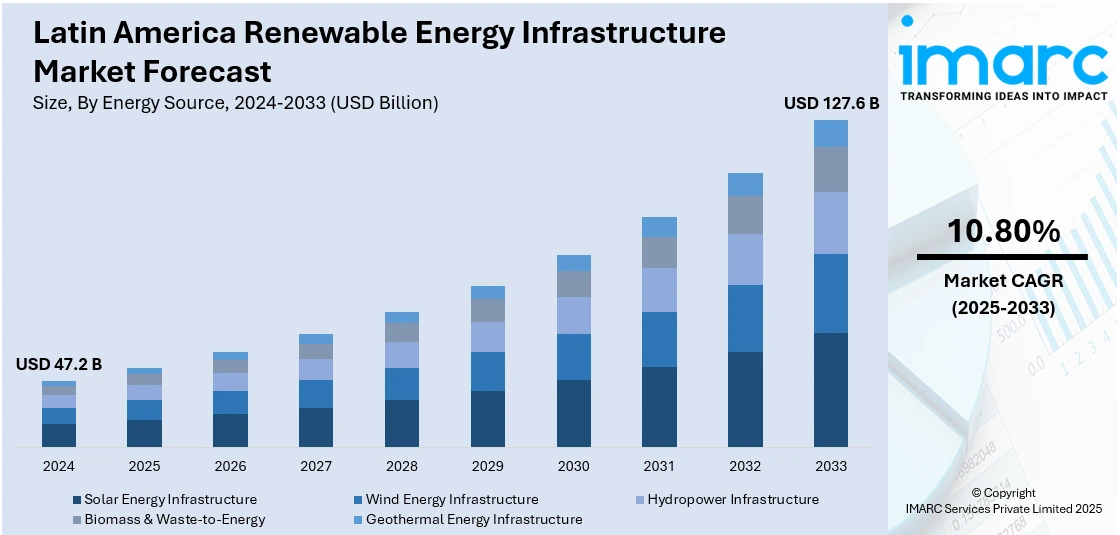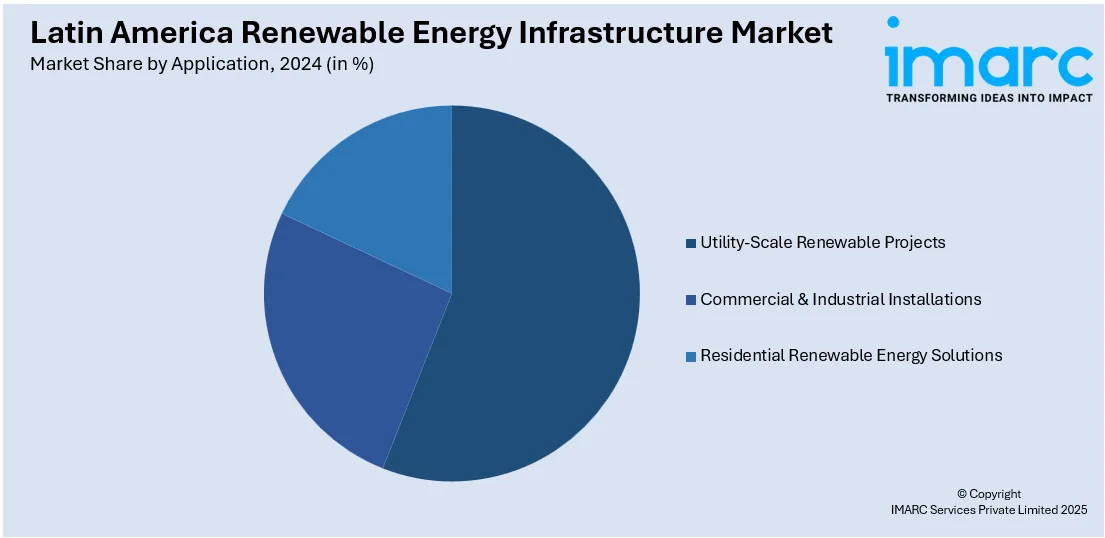
Latin America Renewable Energy Infrastructure Market Size, Share, Trends and Forecast by Energy Source, Component, Application, and Country 2025-2033
Latin America Renewable Energy Infrastructure Market Overview:
The Latin America renewable energy infrastructure market size reached USD 47.2 Billion in 2024. Looking forward, IMARC Group expects the market to reach USD 127.6 Billion by 2033, exhibiting a growth rate (CAGR) of 10.80% during 2025-2033. The market is propelled by numerous government incentives and favorable policies promoting renewable energy (RE) investments, increasing demand for energy due to population growth and urbanization, and the availability of abundant natural resources such as solar, wind, and hydro power potential.
|
Report Attribute
|
Key Statistics
|
|---|---|
|
Base Year
|
2024 |
|
Forecast Years
|
2025-2033
|
|
Historical Years
|
2019-2024
|
| Market Size in 2024 | USD 47.2 Billion |
| Market Forecast in 2033 | USD 127.6 Billion |
| Market Growth Rate 2025-2033 | 10.80% |
Latin America Renewable Energy Infrastructure Market Trends:
Government Policies and Incentives
The Latin America RE infrastructure market is primarily driven by the strong support from governments through favorable policies and incentives. The region has established challenging RE targets in many countries, which have built a strong structure for this sector to thrive. Governments provide tax advantages, along with financial subsidies and additional benefits, that draw both domestic and foreign investors toward RE infrastructure initiatives. The policies aim to boost the development of wind power, solar power, hydroelectric energy, and clean energy technologies, ensuring that RE becomes a significant part of the energy mix. For instance, Brazil and Chile have implemented progressive policies, such as RE auctions, to facilitate the entry of RE companies into the market. Vale partnered with GIP, selling 70% of Alianca Energia for $1 Billion to consolidate solar and hydro assets, boosting Brazil’s renewable energy infrastructure and investment. These efforts are helping the region transition from fossil fuels to cleaner energy solutions, which is driving significant investment in renewable infrastructure, thereby driving the Latin America RE infrastructure market growth.

Growing Energy Demand and Urbanization
The Latin America RE infrastructure market outlook depends heavily on the rapid population growth and the increasing urbanization. The movement of people toward urban centers creates rising electricity needs, which increases stress on the current energy infrastructure. The increasing energy requirements face challenges from traditional fossil fuel-based energy sources because these resources cannot provide sufficient power to areas with poor infrastructure. People view solar and wind power as potential answers for this energy challenge because these renewable technologies can scale up their capacity while operating from decentralized locations. RE energy systems placed near cities minimize transmission loss while enhancing power grid reliability. Governments and energy companies also invest in RE infrastructure to provide stable electricity services to the growing urban population through the reduction of fossil fuel imports. For example, the U.S. Department of Energy (DOE) invested $1.2 billion to establish RE projects in Puerto Rico that include a 100-megawatt solar power facility with batteries for improving the island's power stability. The simultaneous growth of cities and the requirement for sustainable energy solutions drive regional nations to develop renewable infrastructure.
Global Demand for Decarbonization and Sustainable Energy
The increased global emphasis on decarbonization and sustainable energy solutions is boosting the Latin America renewable energy infrastructure market share. With concerns about climate change increasing, countries and companies are under pressure to reduce their carbon footprints and use cleaner energy alternatives. International agreements, such as the Paris Agreement, have mandated countries to reduce global warming by moving from fossil energy to renewables. Latin America, with its ideal conditions for REs production, is playing a vital role in helping meet these global sustainability goals. According to the United Nations Climate Summit, by 2030, Latin America is projected to witness a 460% growth in its utility-scale wind and solar power capacity, reflecting the increasing focus on RE in the region. In addition to this, international development banks and private investors are financing RE activities in Latin America due to its potential to contribute to global decarbonization. This influx of funding is driving the development of new infrastructure projects. As more industries and governments focus on achieving carbon neutrality, the demand for RE infrastructure in Latin America is rising.
Latin America Renewable Energy Infrastructure Market Segmentation:
IMARC Group provides an analysis of the key trends in each segment of the market, along with forecasts at the country level for 2025-2033. Our report has categorized the market based on energy source, component, and application.
Energy Source Insights:
- Solar Energy Infrastructure
- Wind Energy Infrastructure
- Hydropower Infrastructure
- Biomass & Waste-to-Energy
- Geothermal Energy Infrastructure
The report has provided a detailed breakup and analysis of the market based on the energy source. This includes solar energy infrastructure, wind energy infrastructure, hydropower infrastructure, biomass & waste-to-energy, and geothermal energy infrastructure.
Component Insights:
- Power Generation Equipment
- Solar Panels
- Wind Turbines
- Hydroelectric Dams
- Grid Infrastructure
- Energy Storage Systems
- Battery Storage
- Pumped Hydro Storage
- Smart Grid & Digital Solutions
A detailed breakup and analysis of the market based on the component have also been provided in the report. This includes power generation equipment (solar panels, wind turbines, hydroelectric dams), grid infrastructure, energy storage systems (battery storage, pumped hydro storage), and smart grid & digital solutions.
Application Insights:

- Utility-Scale Renewable Projects
- Commercial & Industrial Installations
- Residential Renewable Energy Solutions
The report has provided a detailed breakup and analysis of the market based on the application. This includes utility-scale renewable projects, commercial & industrial installations, and residential renewable energy solutions.
Country Insights:
- Brazil
- Mexico
- Argentina
- Colombia
- Chile
- Peru
- Others
The report has also provided a comprehensive analysis of all the major country markets, which include Brazil, Mexico, Argentina, Colombia, Chile, Peru, and Others.
Competitive Landscape:
The market research report has also provided a comprehensive analysis of the competitive landscape. Competitive analysis such as market structure, key player positioning, top winning strategies, competitive dashboard, and company evaluation quadrant has been covered in the report. Also, detailed profiles of all major companies have been provided.
Latin America Renewable Energy Infrastructure Market News:
- 9 October 2024: The International Union for Conservation of Nature (IUCN) has announced a partnership with global electricity and telecommunications infrastructure firm REDEIA, formerly known as Red Eléctrica de España, to advance environment-friendly energy infrastructure in Latin America and Spain. This collaboration project also aims to support conservation efforts and assessments of biodiversity.
- 28 August 2024: Leading Latin American sustainable firm Scala Data Centers has established the largest renewable energy alliance with Serena, a global leader in sustainable energy initiatives. The partnership aims to supply wind power to Hyperscale data centers, expanding Scala's renewable energy portfolio.
Latin America Renewable Energy Infrastructure Market Report Coverage:
| Report Features | Details |
|---|---|
| Base Year of the Analysis | 2024 |
| Historical Period | 2019-2024 |
| Forecast Period | 2025-2033 |
| Units | Billion USD |
| Scope of the Report |
Exploration of Historical Trends and Market Outlook, Industry Catalysts and Challenges, Segment-Wise Historical and Future Market Assessment:
|
| Energy Sources Covered | Solar Energy Infrastructure, Wind Energy Infrastructure, Hydropower Infrastructure, Biomass & Waste-to-Energy, Geothermal Energy Infrastructure |
| Components Covered |
|
| Applications Covered | Utility-Scale Renewable Projects, Commercial & Industrial Installations, Residential Renewable Energy Solutions |
| Countries Covered | Brazil, Mexico, Argentina, Colombia, Chile, Peru, Others |
| Customization Scope | 10% Free Customization |
| Post-Sale Analyst Support | 10-12 Weeks |
| Delivery Format | PDF and Excel through Email (We can also provide the editable version of the report in PPT/Word format on special request) |
Key Questions Answered in This Report:
- How has the Latin America renewable energy infrastructure market performed so far and how will it perform in the coming years?
- What is the breakup of the Latin America renewable energy infrastructure market on the basis of energy source?
- What is the breakup of the Latin America renewable energy infrastructure market on the basis of component?
- What is the breakup of the Latin America renewable energy infrastructure market on the basis of application?
- What is the breakup of the Latin America renewable energy infrastructure market on the basis of country?
- What are the various stages in the value chain of the Latin America renewable energy infrastructure market?
- What are the key driving factors and challenges in the Latin America renewable energy infrastructure?
- What is the structure of the Latin America renewable energy infrastructure market and who are the key players?
- What is the degree of competition in the Latin America renewable energy infrastructure market?
Key Benefits for Stakeholders:
- IMARC’s industry report offers a comprehensive quantitative analysis of various market segments, historical and current market trends, market forecasts, and dynamics of the Latin America renewable energy infrastructure market from 2019-2033.
- The research report provides the latest information on the market drivers, challenges, and opportunities in the Latin America renewable energy infrastructure market.
- Porter's five forces analysis assist stakeholders in assessing the impact of new entrants, competitive rivalry, supplier power, buyer power, and the threat of substitution. It helps stakeholders to analyze the level of competition within the Latin America renewable energy infrastructure industry and its attractiveness.
- Competitive landscape allows stakeholders to understand their competitive environment and provides an insight into the current positions of key players in the market.
Need more help?
- Speak to our experienced analysts for insights on the current market scenarios.
- Include additional segments and countries to customize the report as per your requirement.
- Gain an unparalleled competitive advantage in your domain by understanding how to utilize the report and positively impacting your operations and revenue.
- For further assistance, please connect with our analysts.
 Request Customization
Request Customization
 Speak to an Analyst
Speak to an Analyst
 Request Brochure
Request Brochure
 Inquire Before Buying
Inquire Before Buying




.webp)




.webp)












